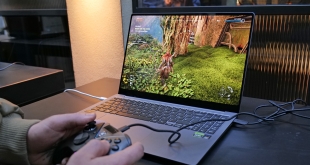
The AMD R9 290X reference card is a two slot design, featuring the traditional small red AMD fan at one side of the cooler, forcing air in and across the length of the PCB. As this is a reference sample direct from AMD we don’t have any accessories with the card.
We should be reviewing some partner cards in the coming month and it will be interesting to see if any of them bundle some new games with the hardware.


The AMD R9 290X reference card is built around a black and red accented plastic shroud, housing the cooler underneath. The PCB is black.

The card has a DVI-I, DVI-D, full sized HDMI and DisplayPort connectors.
R9 Series graphics cards can now support up to three HDMI/DVI displays for use with AMD Eyefinity technology. A set of displays which support identical timings is required to enable this feature. The display clocks and timing for this feature are configured at boot time.
As such, display hot‐plugging is not supported for the third HDMI/DVI connection. A reboot is required to enable three HDMI/DVI displays.

The R9 290X reference card takes power from a single 6 pin and a single 8 pin PCI connector.

There is no Crossfire connector on the R9 290X. This is the first AMD card to offer Bridgeless Crossfire.
There is a dual bios switch on the card – as you can see in the image above. This switch toggles between ‘Quiet Mode’ and ‘Uber Mode’.


This BIOS switch doesn’t actually adjust core clock or memory speeds. It changes the maximum fan speed from 40% to 55% (Quiet Mode to Uber Mode) while holding a maximum default temperature of 95c.
Catalyst Control Center has been redesigned to accommodate the new PowerTune functionality in the AMD R9 290 solution.
Overclocking and Power are now linked into a ’2 dimensional heatmap’. AMD claim that this new heat map interface will make it more intuitive for the end user to adjust product performance. The R9 290X uses a dynamic engine clock and overdriving the core speed works on a percentage.
The fan speed slider has also been reworked. Previous versions of Overdrive would set the fan to a specific RPM. This new system sets an upper limit on the fan RPM but otherwise allows the fan to be managed based on demand and graphics load. At default, the R9 290X fan maxes out based on the current settings of the video BIOS that was booted. Adjusting the maximum fan slider will allow the user to select a different limit.
How does this work in practice?

At the default BIOS setting -’quiet’, the fan speed is limited to a maximum of 40 percent while the software simultaneously holds a maximum default temperature of 95c. We noticed that to maintain the temperature of 95c running the synthetic load test Furmark that the software would actively downclock the core. The image above shows the core running at 727mhz – while holding the temperature at 95c.

At the other ‘Uber’ BIOS setting, the fan speed is limited to a maximum of 55 percent while the software holds a maximum temperature of 95c. Sadly Catalyst Control Center will not switch from 40% to 55% fan settings automatically – even with the BIOS switch in the correct place. We need to manually click ‘default’ in the Performance Overdrive tab – to reset the max speed to 55%. We are hoping that future revisions of the driver will automatically adjust this.
As the fan is more active at this setting, the card isn’t actively downclocking as much as it does when tasked with the synthetic Furmark test. We noticed the core speed would often drop from 1000mhz to around 900mhz.
AMD have clearly had to work out a rather sophisticated set of parameters to try and maintain a maximum default core temperature of 95c, which already seems very high in our opinion.
We discussed this with AMD and we were told ‘R9 290X GPU running at 95C is absolutely normal and intentional.’
I strongly believe if AMD had improved the reference cooler on the 290X that the core speed could have held at 1,000mhz at all times, without the need for this active downclocking based on a set threshold temperature parameter.
On a more positive note, the software does allow the user to adjust settings and drop the maximum temperature to say 85c. Setting the maximum fan speed percentage to (for example) 70% would ensure the temperatures would drop – at the expense of a lot of fan noise. We need to add, that if you moved the temperature slider from 95c to 85c and left the maximum fan setting on 40% then the core would downclock even further to compensate, subsequently losing performance.
It is worth pointing out that Furmark is a synthetic stress test – more intensive than any game we test today, but it does show a potential ‘worst case’ scenario. For the 4K review today, we are using UBER mode with fan speed set at a maximum of 55%.


The R9 290X card is built to quite a high standard, although the reference cooler could have been much better. Take a look at the cooler on the Sapphire R9 280X Toxic Edition for instance which features monster 10mm heatpipes – we can only hope Sapphire will bring out a heavily customised version of the R9 290X in the coming weeks.
 KitGuru KitGuru.net – Tech News | Hardware News | Hardware Reviews | IOS | Mobile | Gaming | Graphics Cards
KitGuru KitGuru.net – Tech News | Hardware News | Hardware Reviews | IOS | Mobile | Gaming | Graphics Cards


